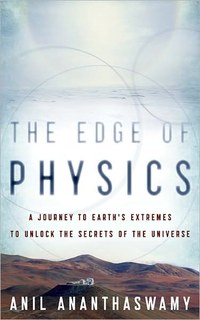Review: The Edge of Physicsby Jeff Foust
|
| Does the public understand and appreciate this work, or are they oblivious to it as they worry about higher profile concerns? That may turn out to be science’s ultimate question. |
Ananthaswamy, a consulting editor for New Scientist, does not exaggerate in the book’s subtitle about going to the “Earth’s extremes” in the name of science. Much of this book is a travelogue as he jets across the planet to remote, extreme locations where scientists have set up shop to peer deep into the universe or look for elusive subatomic particles. His stops include mountaintop observatories in Chile and Hawaii; the desolate Karoo region of South Africa, a proposed site of the Square Kilometer Array radiotelescope; and neutrino detectors in Russia’s Lake Baikal and at the South Pole. (For those worried about the ecological impact of such globetrotting, the book jacket notes that all the commercial air travel involved for the book was carbon-offset.) Needless to say, getting to these sites makes for an interesting book alone.
The book is more than just a collection of accounts of visits to remote observatories and labs. Ananthaswamy explains the science behind these efforts and some of their history, be it the study of the origins of the universe and the nature of dark energy, or the quest for elusive particles that could prove or refute the standard model of particle physics: essential questions to the nature, birth, and even ultimate fate of our universe.
If there’s one thing missing in The Edge of Physics (other than a surprising lack of photos of the exotic locations Ananthaswamy visited; just one grainy black-and-white photo at the beginning of each chapter) it’s a deeper examination of why we are so willing to go to such inhospitable places on (and even inside) the Earth. Yes, the science that’s performed is essential to understanding the universe, but that can be often lost in some of the more esoteric aspects of the science itself and its often impenetrable jargon. Yet many of these projects are funded by governments in the US, Europe, and elsewhere who are ultimately answerable to taxpayers. Does the public understand and appreciate this work, or are they oblivious to it as they worry about higher profile concerns? That may turn out to be science’s ultimate question if future research pushes scientists to even more extreme locations on or beyond Earth in their quest, as the book puts it, to unlock the secrets of the universe.
